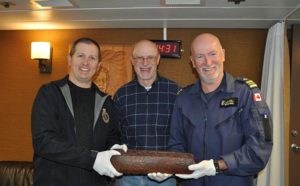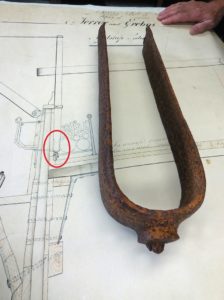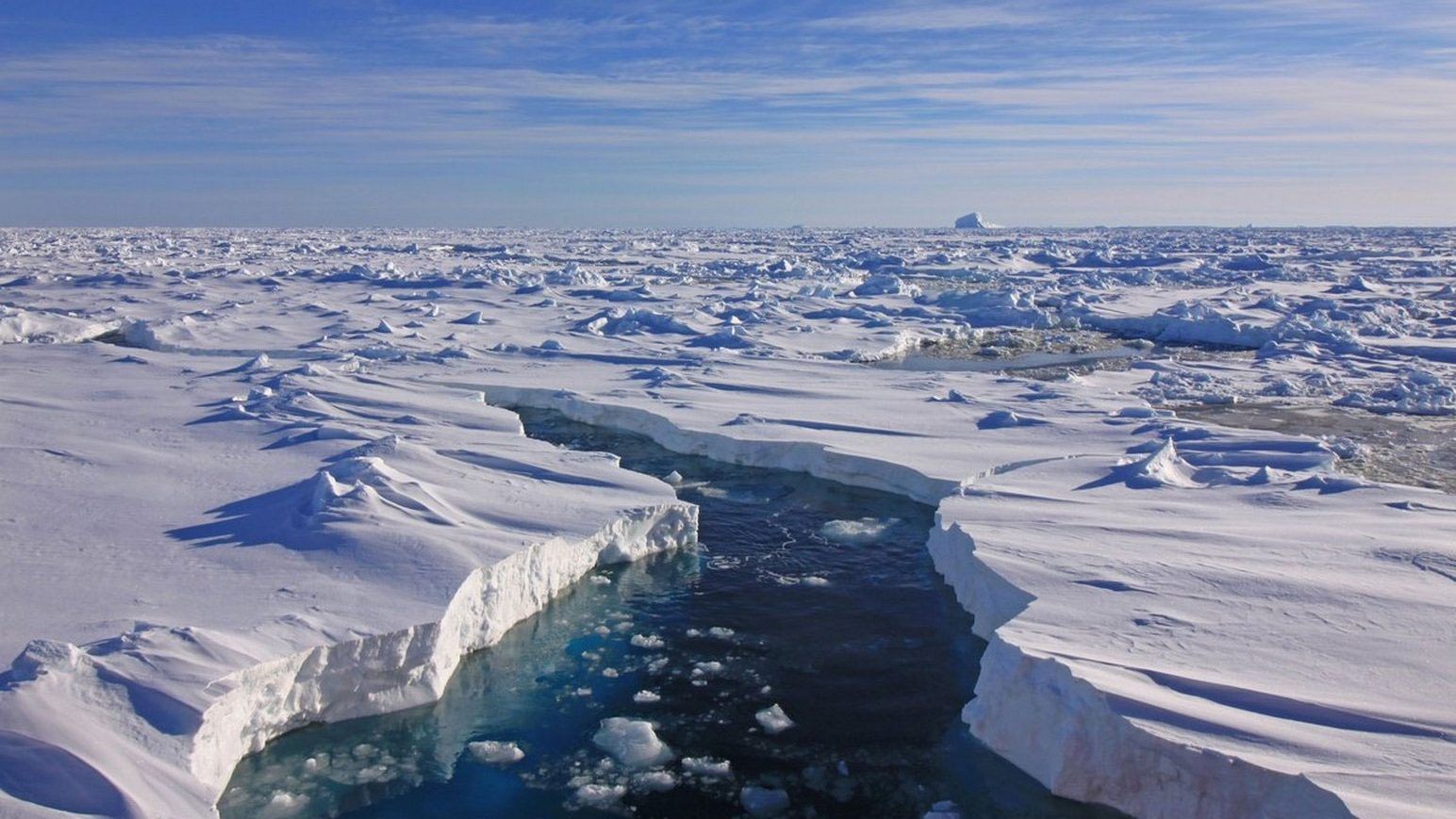GPS Island
Captain Andrew Stirling thought he had the best job in the world. Although officially employed by Transport Canada, he was seconded as helicopter pilot to the Coast Guard. He loved serving with the professional crews on the Laurier. He also loved the Arctic, the beauty of the landscape, the welcoming friendliness of the people, and conducting various missions from the mundane ferrying of personnel and equipment to participating in search and rescue. On the morning of September 1st he was briefed on a fairly-routine mission – to ferry hydrographer Scott Youngblut to one of the nondescript islets nearby so that a GPS shore reference station could be established. It was an unchallenging short hop as a flight, and his other duty, as predator control, was not likely to be very exciting either as he rarely had to unlimber his rifle.
The Messerschmitt Bo 105 helicopter had four seats, and Andrew was pleased to hear that Scott had offered the two empty ones to the archeologists. They had been systematically working their way from north to south, surveying the small islets in Wilmot and Crampton Bay. As Scott was agnostic as to where he set up his station, he readily agreed to the islet next on the archaeologists list. Andrew always enjoyed working with Drs. Douglas Stenton and Robert Park, poking around on the ground and helping however he could.
Doug Stenton: Andrew’s a good guy, a lot of fun to fly with, a lot of fun to work with in the field, very enthusiastic. I nicknamed him “Metallica,” he finds so much stuff, I can barely get my hands on one of my metal detectors … it’s like its welded to him, but he’s good at it … Andrew could sit in the chopper all day and read a book if he wanted to … But he was quite interested from the get-go.
A few minutes after departure they were circling a low sand and gravel island, soon to be christened by them as GPS Island. The Inuit name, unknown to them, was Saunitalik – “there is a bowhead whale skull there.” They did a quick overflight, identifying two lonely caribou and tent circles on the central, west and south areas of the island. As the western one was the primary interest of the archaeologists, Andrew set the helo down nearby. There was no indication that the island would be productive of anything that would help resolve the Franklin mystery. The island was one of many filling the eastern end of Wilmot and Crampton Bay, and the survey launches were concentrating on the open waters to the west.
Andrew Stirling: Scott went off to a little area to the side. We lugged some batteries out there and then he had to set up his station. “You’re good? Yes, okay, you guys are busy,” so off I went for a walk. … because I’m primary predator watch, I had the gun with me, but I don’t go too far. I’m always within sight of them in a short distance away. It wasn’t very far and it wasn’t very long, within 20 minutes.
Stirling had no predetermined plan to survey the island. Andrew was a keen set of eyes, but he wasn’t a trained archeologist. Like all of their helpers, Stenton and Park had drilled into their associates the mantra “look, find, but don’t touch.”
Andrew Stirling: You just scan the ground. Up there on the island or in the Arctic, it’s monochrome, this color, so if anything is different, it sticks out like you know what.
As he walked away from the others Andrew noticed a rock. One of the few features on that nondescript pile of sand and gravel it naturally drew the eye on this.
Andrew Stirling: I walked over there and here’s this bicycle fork looking piece of iron in the sand beside this rock. I just carefully look at it. I don’t touch it. I’m careful where I put my footprints. “Now, what do I do?” [laughs]
Doug was busy documenting the tent rings, while Bob and Andrew surveyed the coast to the south. Bob, who was nearest, responded first to Andrew’s loud whistle. He walked over to see what Andrew had found.
Andrew Stirling: “What you’ve got?” I pointed, and literally, and they might deny it, but he went, “Ooh.” [laughs] I said, “Well, what is it?” He goes, “I don’t know, but it’s good. Okay, where’s Doug?” I whistled and Doug comes over, “What’s he got? Ooh.” Again, “What do you think it is?” He goes, “I don’t know, but it’s iron.” This is a big piece of iron.
Andrew was used to finding small metal fragments on the shore. These could only rarely be attributed to the Franklin expedition, if associated with bones or other items, but a single piece could have originated anywhere. This seemed different. It was a substantial piece, too heavy to have floated to this location. As Doug and Bob took the obligatory photos and measurements of the item in situ, Andrew wandered off to look for other things nearby. Finding nothing else in the immediate vicinity Andrew returned to them after about twenty minutes. Doug stood back and motioned to him.
Doug Stenton: [I]t was really fun, I let Andrew [Stirling] pick it up first because he found it, so I said “there you go” and I said “if you touch it before I say so, you’re going to get arrested,” and he’s looking at me and I said “oh no, pick it up.”
Andrew Stirling: [Doug] says, “Well, you found it, you pick it up.” “Really? Okay.” I go down to pick it up, and Bob, the jokester that he was behind Doug going, “You’re going to jail.” [laughs] “Huh?” He says, “I’m kidding. We have the permits. It’s fine. You can pick it up.”
As the three of them passed the item around they had no idea what it was, but they were sure that it was significant. Andrew could see that the terrestrial archaeologists, who had a friendly rivalry with the underwater archaeologists, were pleased to have discovered such a notable item. Although untrained in assessment of maritime equipment, one indicator that everyone knew was that the Royal Navy obsessively stamped a broad arrow on its equipment in an effort to prevent pilfering from the workshops of its dockyards. Passing the artifact from hand to hand they naturally held it by the heavy base, carefully examining the heavily-rusted tines for any trace of a broad arrow, without success. Then Doug, who had similarly been cupping the item in his hand, turned it over. And he saw the broad arrow.
Doug Stenton: I was holding it just talking to the guys … and I go “wow, I don’t know what it is, it’s like a giant tuning fork” or something like that, and I said “the Parks guys will figure this out, it’s just too bad there is no broad arrows on here” and then I [moved my hand] and “wait a minute, there’s two! And the number 12!” and a few choice comments were made, and the rest is history.

Andrew, still not fully understanding the significance, asked ‘Is that a good thing?” Doug replied, “very good,” so Andrew took it back claiming “finders keepers … This is going to look great in my garden.” They team were “over the top, trying to control their glee and everything, smiling broadly.” The broad arrow positively identified the item as from the British Royal Navy, almost certainly from one of Franklin’s ships. Its location, away from the shore, and its weight, implied that the item had been moved by its original Inuit finders. These observations tended to downplay its significance as to the location of the wreck, hunters could have brought the piece on their sledges from almost anywhere.
Andrew Stirling: He’s like, “All right. Now, let the experts have a good look around this area, just in case you’ve missed something, amateur archaeologist Stirling.” I said, “Well–” He said, Can you just go put it back in the helicopter? Just be careful with it.” “Okay, sure.”
Stirling carried the article to the helicopter. As he approached Scott, who had finished his installation, asked about the obvious activity.
Andrew Stirling: Now I’m an expert … [Scott] says, “Well, what’s that?” I said, “Well, this is from the British Royal Navy ship. Notice the broad arrows [laughs] clearly signifying–” He’s like, “Where did you find that?” Just like a fisherman, “Oh, I caught that fish over there.”
Scott, now engaged in the hunt, started off to join Doug and Bob. Andrew placed the heavy item under the helicopter seat and the group headed off northward. He had been told that “if you see a pile of rocks and it’s not like an ice push, if it looks man-made, it could be a cache, food, or perhaps, burial.” Andrew’s spider-senses were again triggered by an unnatural feature.
Andrew Stirling: Literally, it was probably less than 200 yards away, a pile of rocks. I was like, “Okay, it looks–” There was this perfect half-moon shape- I said, “Well, that’s just too perfect to be a rock … part of it was sticking, just laying against a rock one half and the other half was embedded in the ground surface but flush, wasn’t really at depth, you could see the whole wood on the top, big square nails.”
Andrew had found lots of indeterminate wood before. A trick that he had been told was to look for iron square-headed nails, typical of the nineteenth century. This piece had an iron nail. As he looked around he found another piece nearby, again, with iron nails. He was excited, “This is good. This is old. I don’t know what that other thing was, but I know this is old.” He was again soon joined by Doug and Bob.
Andrew Stirling: [Doug] looks at me square in the eyes. He says, “Are you going to let us find anything today?” I look him squarely in the eyes back and say, “Hey, eyes to the ground, fellows, eyes to the ground.” Again, this is the fun rapport you have … He’s like, “All right, go find something else.” I’m like, “Oh, sure. That’s all I am to you.”
Doug carefully set to excavating the partially-buried wooden item. There was, unfortunately, no obvious broad arrow on it. When he held it next to the other piece, laying them together they fit perfectly making a wooden oval cover with a central open notch. Again, the terrestrial archeologists could not immediately identify the item, but the fact that it was found on the shore tended to imply that the previous heavy iron piece perhaps had been brought ashore entangled in broken rigging and taken to the stone. Together, the two finds tended to support a nearby wreck. Not anticipating recovery of large artifacts, they had no artifact bags anywhere near big enough for these items and so Doug wrapped them up in his down vest and jacket, took them to the helo, and put them onto the back seat. They had spent several hours on their impromptu search, and needed to return to the Laurier.
Andrew Stirling: Doug says, ”Okay, that’s it.” He says, ”We go back to the ship. Please don’t say anything.” It’s like, ”Hey, it’s your call. I’m fine.” He says, ”No, seriously, this is really big, we’ve got to be very careful given what could happen” “That’s fine. No worries. I’m not going to say a thing.”

